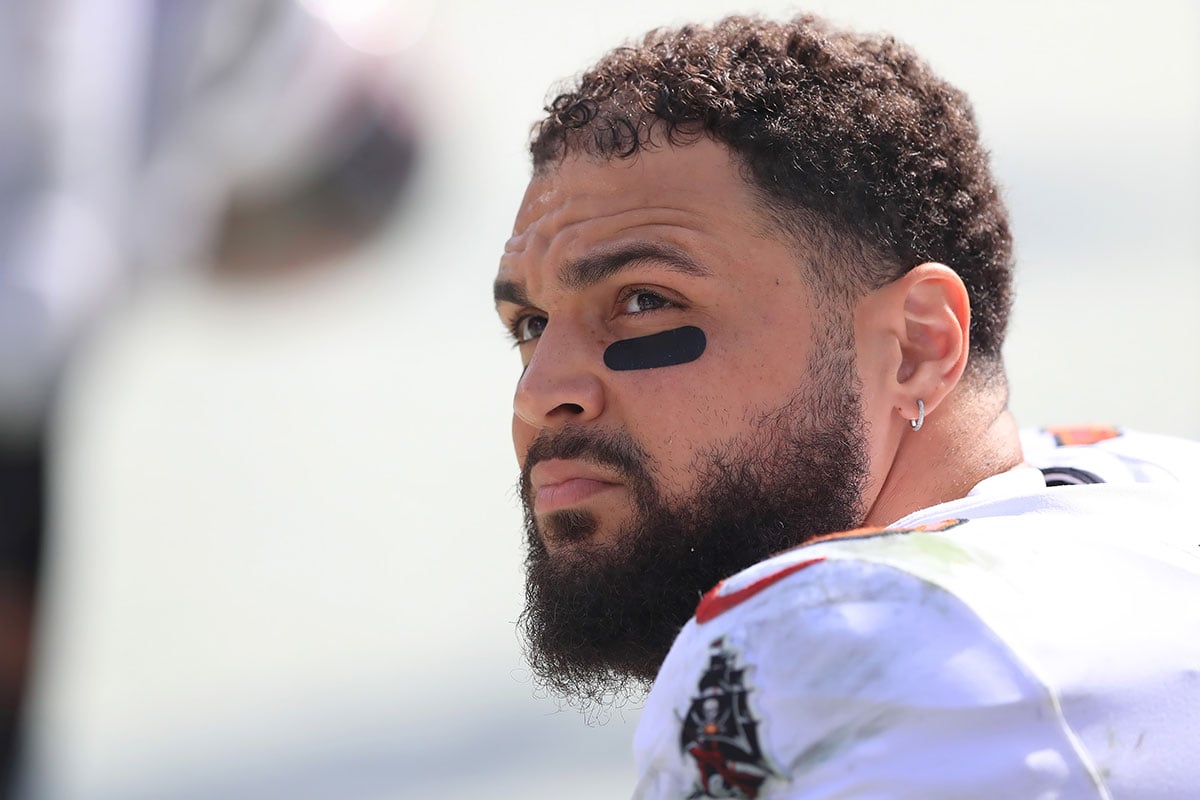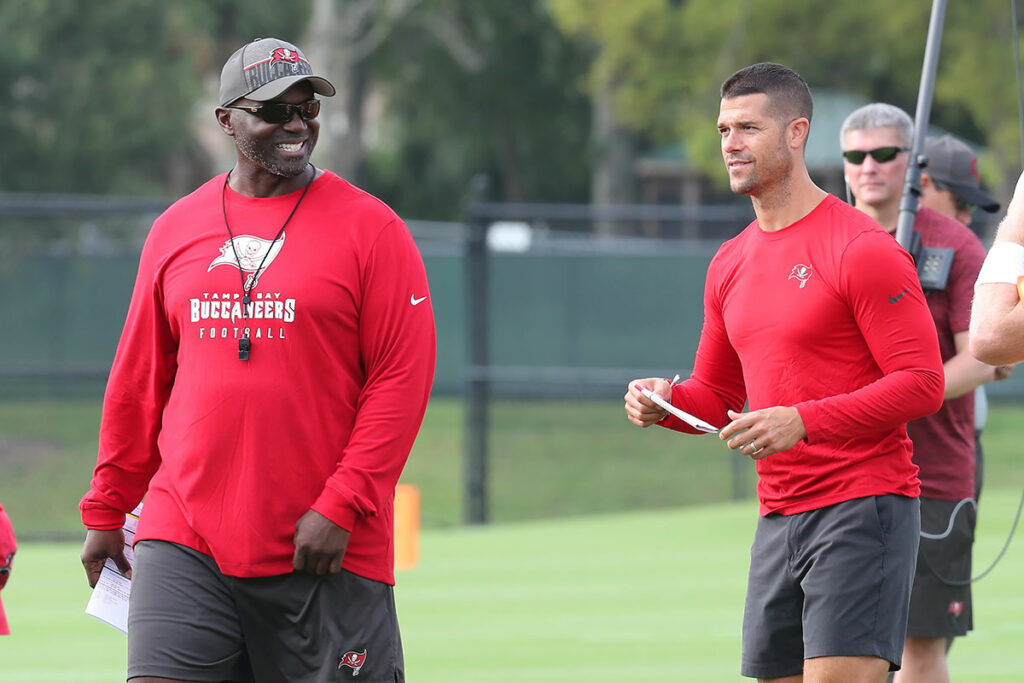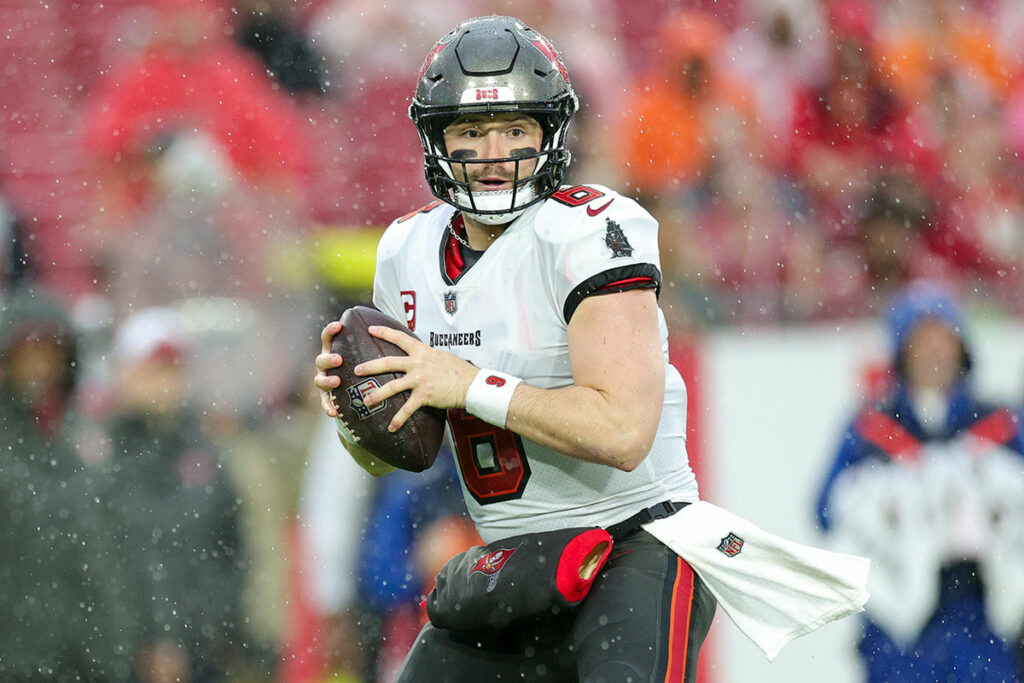A few weeks ago, Pewter Report entertained the PR Roundtable discussion of which Bucs player was the most important to prioritize come the 2024 off-season. The Bucs are facing possible departures of 19 players to unrestricted free agency. Of those 19, I’ll make the case for six possible priorities (including the elephant-in-the-room controversial one) in terms of how much they might cost the team.
Can the Bucs afford all six? Can they afford all six plus and peruse the free agent market for upgrades? The short answer to both questions is yes. The long answer (as most are with me) is it depends … on what the Bucs want to do.
Bucs’ 2024 Cap Situation
Let’s start with the Bucs’ cap commitments for 2024. Per Over the Cap, Tampa Bay has 40 players under contract for 2024 for a total cap liability of $197,913,337 with only $132k in dead cap due to the termination of Jose Ramirez’s rookie contract (he’s now on the practice squad). That would leave them with just over $47 million in cap space right now. This is the 11th most in the NFL. I cannot overstate the positive impact that the Bucs’ decision to absorb the entirety of Tom Brady’s dead cap hit following his retirement this year, rather than spreading it over two years, has on the long-term prospects of this team.
Now that 40 players under contract is a bit misleading. It includes players who have “dummy” years on their current deals who will not actually be under contract next year. This includes the following players: Mike Evans, Antoine Winfield Jr., Lavonte David, Baker Mayfield, Greg Gaines and Matt Feiler. Once you properly account for those players the Bucs actually have 34 players under contract.
Now many of those I just listed should be or likely will be priorities for the team to bring back. And if the team is able to retain those players services, they will receive minor cap savings as the dead cap hits their contracts would void to would prorate.
Still, all of this is based on the Bucs’ static situation at the moment. They can improve their cap space in two ways. First, they can restructure several contracts. There is over $65 million in available opportunity if they went max restructure on most of those contracts. Second, the Bucs also have a few players who are possible cut candidates.
The bottom line here is that unlike 2023, the Bucs have enough room to do almost anything they want with regards to free agency. And so, they will have the room to bring back all of these players if they so choose. So, what might they choose to do?
Bucs WR Mike Evans
I don’t have to tell you, the Pewter Report reader, the Mike Evans – Bucs saga. But I’m going to recap the highlights anyways. Evans is playing on the last year of his deal. On the eve of training camp, it came out that he wanted an extension and the team declined to acquiesce to his reported demands. Those demands? A deal in the neighborhood of Cooper Kupp’s three-year $80.1 million pact with the Los Angeles Rams.
At a $26.7 million average annual value, Kupp currently has the third highest per-year salary among all wide receivers. At the time I noted that Evans’ recent play and age didn’t warrant that kind of contract, and I stand by that analysis.
1/2 If Evans is looking 4 Kupp $ that’s a tough sell. He isn’t the volume target driver that others are. Kupp is an outlier due to role in offense and volume + Rams are making “1 last go”.
Deebo/Metcalf/Brown all got $25M/yr recently and I have trouble seeing Evans going above. https://t.co/tjaZoDPAy6
— Joshua Queipo (@josh_queipo) September 1, 2023
But here’s the thing. Evans has, in Tom Brady-like fashion, turned back the hands of time. Currently on pace for 134 targets, 80 catches, 1,308 yards, 13 touchdowns and 340 yards after the catch. Those would be high-water marks since 2018 for targets, catches and yards, 2021 for touchdowns and a career high in yards after catch.
Evans is legitimately playing better at 30 years old than he has in several years. This will cost the Bucs (as it should), several million dollars on his next contract.
Where I thought an extension in the $22.5 million/year range was in-line with his market value preseason, Evans is now realistically looking at a three-year, $75 million deal, edging him closer to the $26.7 million Kupp mark. Now, that $25 million/year number won’t mean he costs the Bucs that much in cap space in 2024.
As with most veteran deals, the Bucs will prorate the signing bonus and escalate the salaries over the life of the deal. They may even tack on void years to lessen the cap burden in the first couple years of the deal. A reasonable projection of how that contract could work out would see Evans’ 2024 cap hit at $17.3 million.
This may seem high, but when you consider he was due to cost the Bucs $12.2 million in dead cap, his real burden on their current cap is just a touch over $5 million. This pairing works well for all parties involved as it gives the Bucs a player show has accounted for over one-third of their receiving yards this season at minimal real cost while giving Evans the contract he has been seeking to end his career in Tampa Bay.
Bucs FS Antoine Winfield Jr.
This one is a bit of a revisit for me. Two months ago, in the midst of his torrid start to the season I projected Winfield could fetch an AAV (average annual value) of $19.375 million over three-years. That article was written on the eve of the Bucs’ Week 6 matchup with the Lions. At the time Winfield was on pace for 132 tackles, nine tackles for loss, 17 passes defensed and nine forced fumbles. With 10 additional games under his belt those numbers now project to 130 tackles, five tackles for loss, two interceptions, 13 passes defensed and six forced fumbles, while making a case for being THE best safety in the NFL.
And here’s the thing no one is talking about enough with regards to Winfield, he is the player the league has claimed Derwin James was going to be. Winfield is up there with Atlanta’s Jassie Bates III as the best top-down deep safeties. But you can take Winfield and put him in the slot and allow him to man up the best slot receivers in the NFL. Layer on top of that he is incredible in the box as a blitzer and a run defender. Winfield can do it all. He is the chess piece defensive coordinators covet.
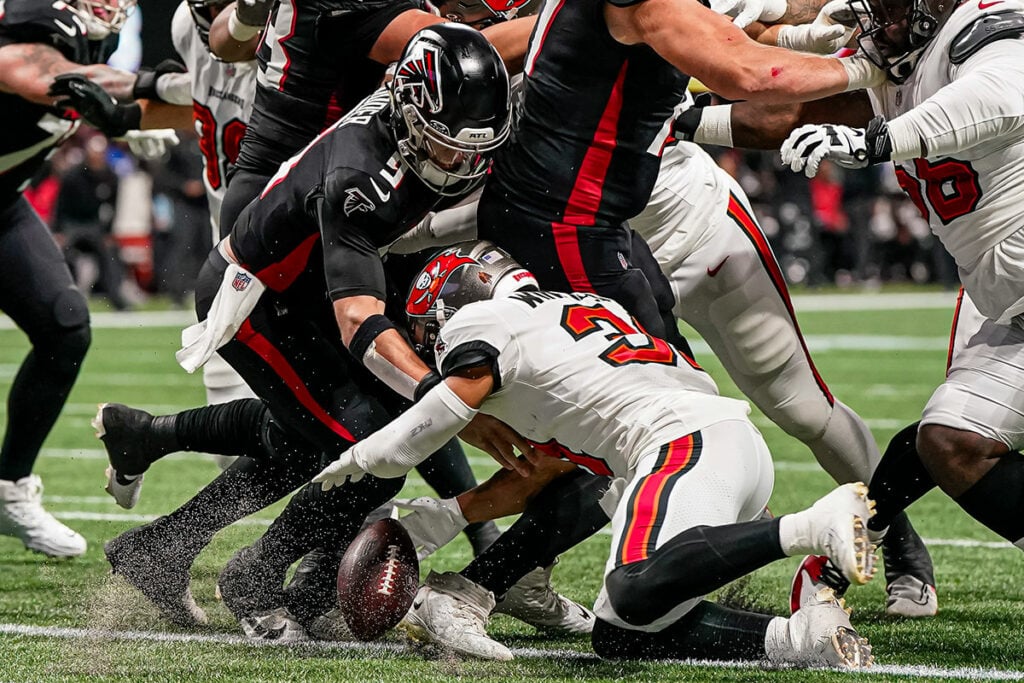
Bucs FS Antoine WInfield Jr. and Falcons QB Desmond Ridder – Photo by: USA Today
Since my October article, Winfield has bolstered his case to be the top-paid safety in the NFL and could be the first safety to hit the $20 million mark. Now that won’t happen in 2024. The Bucs are likely to franchise tag their superstar safety. That number should be around $17.25 million. Now the Bucs will be on the hook for that entire figure on the cap, as they can’t manipulate the cap number on a tag. But it still represents incredible value for what Winfield brings to the table.
Bucs ILB Lavonte David
David continues to operate at an incredibly high level at almost 34 years old. Still one of the most cerebral ‘backers in the NFL, he beats blockers to spots by anticipating what is about to happen. His missed tackle rate is under 10% for the third consecutive season. But with 16 tackles for a loss, 3.5 sacks and five passes defensed, the splash plays have returned to his game. David helps cover up warts in Todd Bowles’ scheme by understanding the opposing offense so well. The Bucs are likely to welcome David back with open arms for a 13th season if he still wants to play in 2024.
With Devin White all but gone next year David becomes even more important to the Bucs as they transition to one of three younger linebackers in K.J. Britt, J.J. Russell and SirVocea Dennis. David can still do it all, fitting the run, pursuing in space, playing in coverage and blitzing when asked.
David’s play is worth much more than the $4.5 million the Bucs are currently paying him. That number will actually increase to $7.5 million when he hits incentives down the stretch. With another year on his tires, it is possible the Bucs can bring him back for less next year. But I truly believe that David agreed to the reduced amount in 2023 as a favor to the cap-strapped Bucs.
The 2024 season will see Tampa Bay in a better position and they could reward the team-first David with a pay bump. Don’t be surprised if he re-signs for another year at $5.5 million with incentives to hit over $8 million.
Bucs LG Aaron Stinnie
Stinnie began the year as a reserve behind free agent acquisition Matt Feiler. But with Feiler injured after suffering some high-profile losses in the first few weeks of the season, Stinnie was able to step in and provide more consistency. The Bucs run game immediately improved after Stinnie’s addition and the line overall has been clicking at an impressive clip of late.
He isn’t impressive physically and a bit undersized for the position, but Stinnie competes every snap and brings the aggressive mentality that plays up his skill set. Stinnie’s 97 efficiency rating in pass blocking is 34th at the position, while he ranks 27th in run block grade and 29th in pass block grade from Pro Football Focus. Stinnie is becoming the definition of solid production. But he is far from perfect. He has allowed a quarterback pressure on 5.28% of his pass blocking reps. That mark is 40th of 57 qualifying guards.
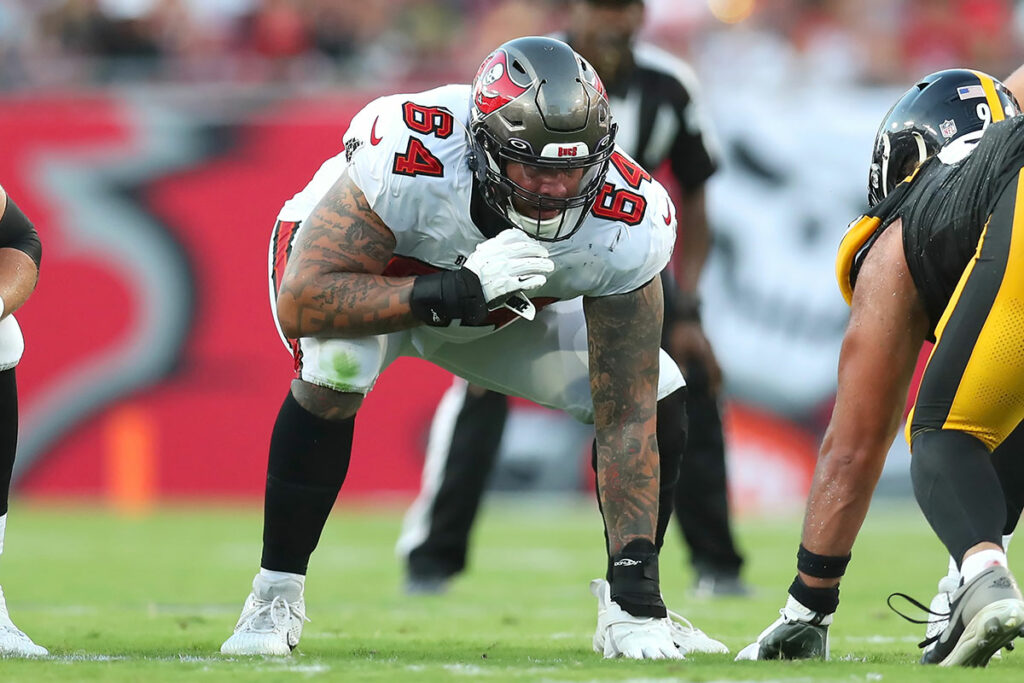
Bucs LG Aaron Stinnie – Photo by: Cliff Welch/PR
Because of his limited playing time and lack of high-end play Stinnie is unlikely to break the bank when negotiating with the Bucs. Looking across the landscape of the NFL, quality fringe starter guards routinely sign for less than $3.5 million. Feiler, Graham Glasgow, Dan Feeny, Halapoulivaati Vaitiai all have signed for the number or less. Stinnie, coming off of a one year, $1.4 million deal will be in line for a raise, but not that large of one. Look for the Bucs to re-sign him for another year at $2-2.5 million.
Bucs K Chase McLaughlin
McLaughlin has been a revelation, bringing Ryan Succop-like consistency plus range to the position. McLaughlin has been a legitimate weapon for head coach Bowles, one he can deploy from the opposition’s 40-yard line. He is 23-of-25 on the season with his only two misses being blocks while he has been perfect on extra points. McLaughlin also sports five field goals of 50+ yards with a long of 57. A reliable kicker with a big leg is a must in today’s NFL and the Bucs have found just that with McLaughlin.
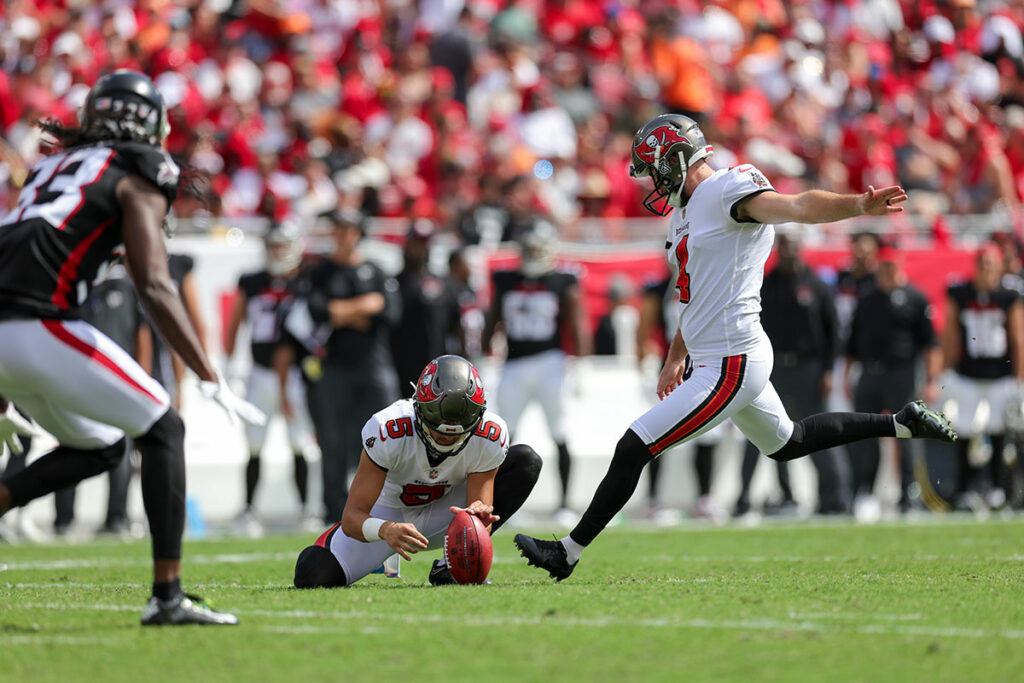
Bucs K Chase McLaughlin – Photo by: USA Today
Joey Slye signed a two-year pact with the Washington Commanders that could serve as a model for a deal between the Bucs and McLaughlin in 2022. Slye had converted 77-of-93 field goals (82.8%) with 13 of 21 (61.9%) converted from beyond 50. McLaughlin is currently at 90-of-110 (81.8%) and 22-of-27 (81.5%) from beyond 50 for his career. This bodes well for McLaughlin to get a higher average annual value than Slye’s $2.225 million. McLaughlin could secure himself a two-year, $6 million deal.
Bucs QB Baker Mayfield
Be honest. Did you immediately scroll down to find this one? Because I purposefully saved it for last to see if you did. Mayfield has been a completely polarizing figure since his days in college and that has followed him to Tampa Bay. As a Bucs fan it seems you are required to have a strong opinion on Tampa Bay’s current QB1 and it has to be either A) he is the next franchise savior. A quarterback who is top tier but has been a victim of poor circumstances. With health and stability, he will ascend to a Top 10 quarterback in the NFL and bring the playoffs year-after-year
Or B) Mayfield is a bottom feeder starter who should have been benched long ago for Kyle Trask who has enough unknown surrounding him he could be better. Also you are to believe that the Bucs should select a quarterback early in the 2024 draft because Baker will only breed mediocrity for years to come.
I have long-maintained Mayfield is a microcosm of the 2023 Bucs team. He is mostly average but with high variance. So, the highs look really good. And the lows can look really ugly. But the aggregate is a mid-tier quarterback.
Here are some data points to support this extremely controversial opinion. He is currently ranked 18th of 28 qualifying quarterbacks in both overall and passing grade from PFF. Likewise, he is 18th in big-time throw rate and 16th in turnover-worthy play rate from the same source. His EPA/dropback is 12th in the league.
And this version of Mayfield is playing in the 10–19-yard range better than he ever has in his career. This is the area of the field that gives quarterbacks the most trouble. He has been able to accomplish all this without the aid of his normally solid deep game. If he can regain that form, it legitimately unlocks a level of play he previously has never hit before. But it is reasonable to question whether that happens or if he can establish a level of consistency that a team would be comfortable with.
Add onto all of this that the Bucs currently rank first in the NFC South and the Saints just lost on Thursday Night Football. Following that result the Bucs now have an 83% chance to make the playoffs and Mayfield has been a huge driver of that success. Assuming that outcome one has to start looking at other quarterbacks who were once written off that then went on to lead a team to the playoffs, re-writing their narrative to once again being a starting quarterback in the NFL, albeit one in the second tier of quarterbacks. Two such stories come to mind.
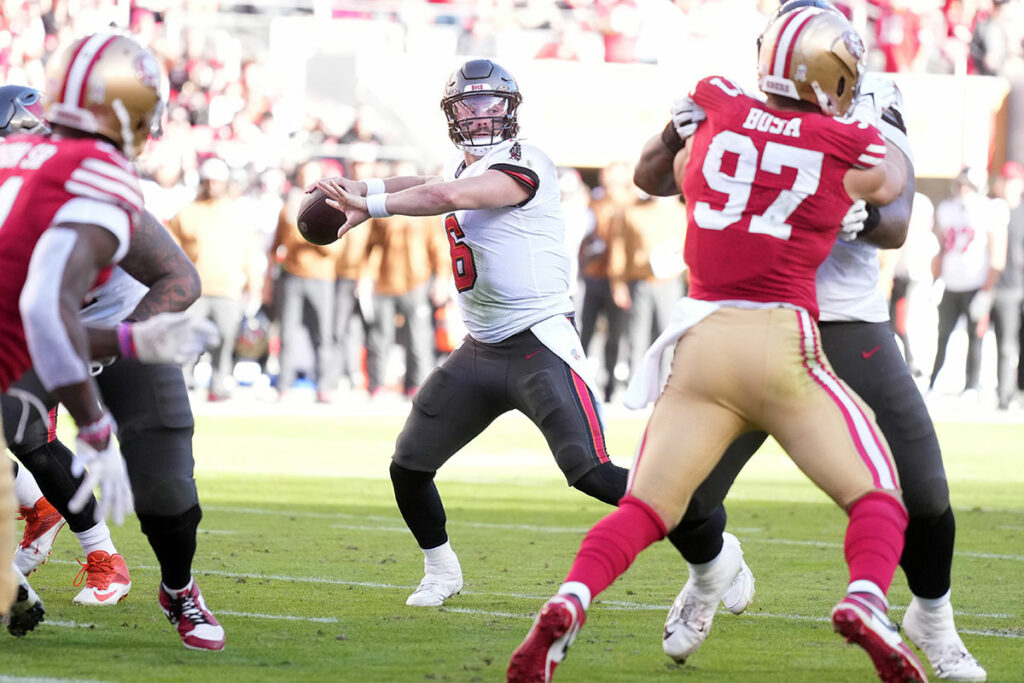
Bucs QB Baker Mayfield – Photo by: USA Today
In 2019 Teddy Bridgewater stepped in for an injured Drew Brees and helped keep the Saints on track to make the playoffs over a multiple-game stretch. He completed 68% of his passes while tossing nine touchdowns to just two interceptions while generating a big-time throw rate that was 1.3% higher than his turnover-worthy play rate and averaging 7.1 yards per attempt.
Following that season Bridgewater parlayed that performance into a three-year, $63 million deal with the Carolina Panthers. That was 2020 when the NFL salary cap was $198.2 million. His $21 million AAV represented 10.6% of the salary cap. If we account for the inflation to the $242 million the 2024 salary cap is likely to be that deal inflates to a bit over $25 million/year.
And just last year Geno Smith was the talk of the NFL world when he ranked second in big time throw rate and eighth in PFF grade while throwing for almost 4,300 yards, 30 touchdowns and 7.6 yards per attempt and leading the Seahawks to the playoffs in surprising fashion. Smith was rewarded with a three-year, $75 million deal with a $25 million AAV.
Contrast that with Mayfield’s current pace of 4,027 yards, 29 touchdowns and a yards per attempt mark of 7.1 while leading the Bucs to the precipice of the playoffs. His play/performance/statistical production compares well with Smith last year. It is reasonable to expect a potential contract extension to look similar (maybe slightly less than) to Smith’s deal. Let’s estimate Mayfield is able to get 95% of Smith’s contract. That would be three years and $71.25 million with about $25 million fully guaranteed.
This would be a good deal for both sides. Mayfield would get a significant raise over his $4 million salary this year. He would also get the opportunity to play out the contract as long as he keeps getting the Bucs to the playoffs. From the team’s standpoint they get an opportunity to capitalize on Mayfield’s improved play with very little downside and the opportunity to cut bait any time after the 2024 season.
This also wouldn’t preclude the team from drafting a quarterback of the future to sit in year one behind Mayfield a la Patrick Mahomes and Alex Smith in Kansas City a while back. This gives the Bucs the ability to try to win both now and later. A deal like this would cost Tampa Bay around $10 million in 2024 cap space.
The Grand Total
Six players who will most likely be priorities for the Bucs to varying degrees. The total for all of their contracts would eclipse $175 million in total value and a total AAV of $77 million. That technically surpasses the $65 million in cap space the team has available at this time. But due to the way the deals would be structured the actual cap stress they would cause would actually come in somewhere around $37 million.
This would give the Bucs $28 million plus restructures/cuts to continue to reshape their roster. Make no mistake the Bucs have plenty of room to do one, multiple or all of these moves in the offseason. Should they is another story. But they certainly can.
Josh Queipo joined the Pewter Report team in 2022, specializing in salary cap analysis and film study. In addition to his official role with the website and podcast, he has an unofficial role as the Pewter Report team’s beaming light of positivity and jokes. A staunch proponent of the forward pass, he is a father to two amazing children and loves sushi, brisket, steak and bacon, though the order changes depending on the day. He graduated from the University of South Florida in 2008 with a degree in finance.

